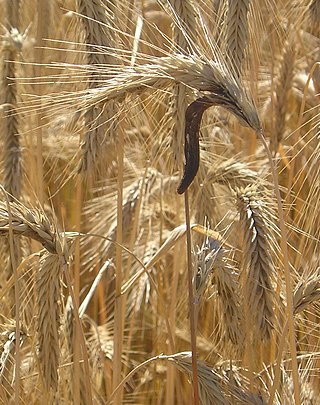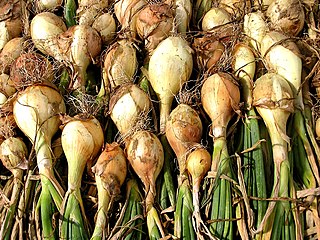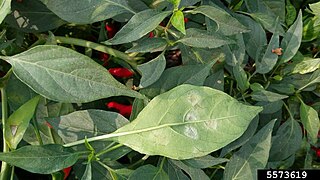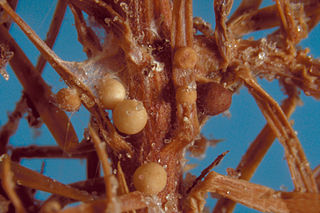
Botrytis cinerea is a necrotrophic fungus that affects many plant species, although its most notable hosts may be wine grapes. In viticulture, it is commonly known as "botrytis bunch rot"; in horticulture, it is usually called "grey mould" or "gray mold".

Texas root rot is a disease that is fairly common in Mexico and the southwestern United States resulting in sudden wilt and death of affected plants, usually during the warmer months. It is caused by a soil-borne fungus named Phymatotrichopsis omnivora that attacks the roots of susceptible plants. It was first discovered in 1888 by Pammel and later named by Duggar in 1916.

A sclerotium, is a compact mass of hardened fungal mycelium containing food reserves. One role of sclerotia is to survive environmental extremes. In some higher fungi such as ergot, sclerotia become detached and remain dormant until favorable growth conditions return. Sclerotia initially were mistaken for individual organisms and described as separate species until Louis René Tulasne proved in 1853 that sclerotia are only a stage in the life cycle of some fungi. Further investigation showed that this stage appears in many fungi belonging to many diverse groups. Sclerotia are important in the understanding of the life cycle and reproduction of fungi, as a food source, as medicine, and in agricultural blight management.

White onion or Allium cepa are a cultivar of dry onion which have a distinct light and mild flavour profile. Much like red onions, they have a high sugar and low sulphur content, and thus have a relatively short shelf life. White onions are used in a variety of dishes, such as those of Mexican and European origin. Their uses in dishes often relate to their mild nature, they are often included in dishes to provide a light, fresh and sour taste to dishes and are often added uncooked to dishes such as salads.

Rhizoctonia solani is a species of fungus in the order Cantharellales. Basidiocarps are thin, effused, and web-like, but the fungus is more typically encountered in its anamorphic state, as hyphae and sclerotia. The name Rhizoctonia solani is currently applied to a complex of related species that await further research. In its wide sense, Rhizoctonia solani is a facultative plant pathogen with a wide host range and worldwide distribution. It causes various plant diseases such as root rot, damping off, and wire stem. It can also form mycorrhizal associations with orchids.

Damping off is a horticultural disease or condition, caused by several different pathogens that kill or weaken seeds or seedlings before or after they germinate. It is most prevalent in wet and cool conditions.

Leveillula taurica is an obligate fungal pathogen, from the phylum Ascomycota, which causes powdery mildew on onion. This disease prefers warm, dry environments. It is rare in the United States, and is currently restricted to western states. Globally, it is also a minor problem with limited occurrences in the Middle East, Europe, and South America. L. taurica causes powdery mildew of onions, but is also known to infect other allium, solanaceous, and cucurbit species. The disease has appeared in parts of the Middle East, the Mediterranean, and South and North America. Currently, it is not a cause for major concern in the U.S. and throughout the world, as its geographic extent is sparse. In addition, it is relatively easy to control through basic sanitation and reducing water stress.

Macrophomina phaseolina is a Botryosphaeriaceae plant pathogen fungus that causes damping off, seedling blight, collar rot, stem rot, charcoal rot, basal stem rot, and root rot on many plant species.

Sclerotinia sclerotiorum is a plant pathogenic fungus and can cause a disease called white mold if conditions are conducive. S. sclerotiorum can also be known as cottony rot, watery soft rot, stem rot, drop, crown rot and blossom blight. A key characteristic of this pathogen is its ability to produce black resting structures known as sclerotia and white fuzzy growths of mycelium on the plant it infects. These sclerotia give rise to a fruiting body in the spring that produces spores in a sac which is why fungi in this class are called sac fungi (Ascomycota). This pathogen can occur on many continents and has a wide host range of plants. When S. sclerotiorum is onset in the field by favorable environmental conditions, losses can be great and control measures should be considered.

Stemphylium solani is a plant pathogen fungus in the phylum Ascomycota. It is the causal pathogen for grey leaf spot in tomatoes and leaf blight in alliums and cotton, though a wide range of additional species can serve as hosts. Symptoms include white spots on leaves and stems that progress to sunken red or purple lesions and finally leaf necrosis. S. solani reproduces and spreads through the formation of conidia on conidiophores. The teleomorph name of Stemphyllium is Pleospora though there are no naturally known occurrences of sexual reproduction. Resistant varieties of tomato and cotton are common, though the pathogen remains an important disease in Chinese garlic cultivation.
Pyrenochaeta terrestris is a fungal plant pathogen that infects maize, sweet potatoes, and strawberries. This plant pathogen causes a disease in onion that is commonly called pink root. P. terrestris is also known to infect shallots, garlic, leeks, chives, cantaloupe, carrots, cauliflower, cowpea, cucumbers, eggplants, lima beans, millet, oats, peas, peppers, potatoes, spinach, sugarcane, and tomatoes.
Magnaporthe salvinii is a fungus known to attack a variety of grass and rice species, including Oryza sativa and Zizania aquatica. Symptoms of fungal infection in plants include small, black, lesions on the leaves that develop into more widespread leaf rot, which then spreads to the stem and causes breakage. As part of its life cycle, the fungus produces sclerotia that persist in dead plant tissue and the soil. Management of the fungus may be effected by tilling the soil, reducing its nitrogen content, or by open field burning, all of which reduce the number of sclerotia, or by the application of a fungicide.

Colletotrichum coccodes is a plant pathogen, which causes anthracnose on tomato and black dot disease of potato. Fungi survive on crop debris and disease emergence is favored by warm temperatures and wet weather.
This article summarizes different crops, what common fungal problems they have, and how fungicide should be used in order to mitigate damage and crop loss. This page also covers how specific fungal infections affect crops present in the United States.

Peronospora destructor is a plant pathogen. It causes downy mildew on leaves of cultivated and wild Allium. Allium cepa is most often affected, while Allium schoenoprasum (chives) and Allium porrum (leek) are only occasionally affected.

Botrytis allii is a plant pathogen, a fungus that causes neck rot in stored onions and related crops. Its teleomorph is unknown, but other species of Botrytis are anamorphs of Botryotinia species. The species was first described scientifically by Mancel Thornton Munn in 1917.

Verticillium dry bubble, recently named Lecanicillium fungicola, is a mycoparasite that attacks white button mushrooms, among other hosts, during its generative period. L. fungicola infects the casing layer on the cap structure of several edible mushrooms. This fungal pathogen does not typically infect wild mushrooms, but more commonly cultivated mushrooms are infected such as A. bisporus, which are typically grown in large quantities. Severity of disease depends on several factors, including timing of infection and environmental conditions. Dry bubble follows the typical verticillium life cycle, although insect vectors play a large role in the spread of this disease. Control for L. fungicola is limited, and strict measures must be taken to prevent the spread of infection. L. fungicola is a devastating pathogen in the mushroom industry and causes significant losses in the commercial production of its main host A. bisporus. Annual costs for mushroom growers are estimated at 2–4% of total revenue.

Botrytis squamosa is a fungus that causes leaf blight on onion that is distinctly characterized by the two stages – leaf spotting followed by blighting. The pathogen is an ascomycete that belongs to the family Sclerotiniaceae in the order Helotiales. The lesions start out as whitish streaks and take on a yellow tinge as they mature. They cause yield losses up to 30%. This fungus is endemic to the USA and has also been reported in Europe, Asia, and Australia. Typical management of this disease includes chemical fungicides with significant efforts being made to establish a means of biological control.

Puccinia porri is a species of rust fungus that causes leek rust. It affects leek, garlic, onion, and chives, and usually appears as bright orange spots on infected plants.

Agroathelia rolfsii is a corticioid fungus in the order Amylocorticiales. It is a facultative plant pathogen and is the causal agent of "southern blight" disease in crops.

















